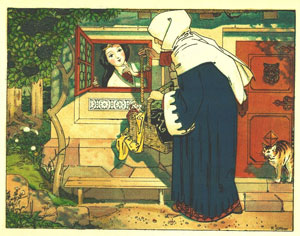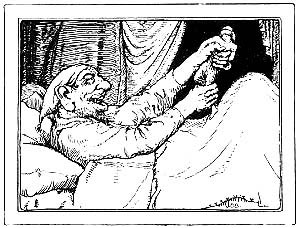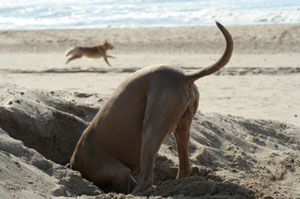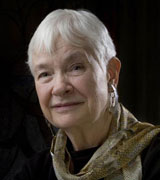
DIVING IN THE MOON
HONORING STORY, FACILITATING HEALING
Therapeutic Learning
© Kay Stone
What makes a story a source of healing? I asked myself this as I prepared to fly south to Florida to visit my sister Jolene, who is undergoing chemotherapy. I was aware that telling stories face-to-face with a single listener is quite different than performing for an audience, and I was prepared to be flexible. From past experiences I knew that every face-to-face encounter is for a particular person, situation, time, and place. Anything can happen, because it is an entirely interactive and unpredictable situation. I wasn’t asking myself this question to find an answer, but to be alert to answers that would arise from the actual experience. And indeed they did. I realized early on that all stories can be therapeutic, but personal storytelling is deeper and more powerful than audience performance. At its best, it is a labor of love. I’ll share a few examples to illustrate these points.
My first one-on-one storytelling experiences were with my son Nathaniel, entertaining him while putting him to bed. I was in for a surprise. When he was five years old he saw the Disney version of Snow White and the Seven Dwarfs, and was very distressed. Distressed but not frightened, as I had been when I saw the film at age five. Nathaniel wanted me to tell him the story every night, and somehow I understood that he was not asking because he liked the story — quite the opposite — but because he was trying to work something out. So, for about a week I told the story over and over — the Grimm version rather than the Disney version.

On the last night he said, “When you tell that story tonight I want the bad mother to go to sleep for 100 years and wake up a nice lady.” He had worked it out. Redemption was an alternative to death, but it had to be “true” in his own mind, not manipulated to make a happy ending. His use of “Sleeping Beauty” was interesting, since I’d never told him that story, but he seemed to understand the archetypal nature of sleeping and death. We often don’t give five-year-olds credit for such deep thinking, missing some important insights. As his own occasional “bad mother,” I was paying attention, and was impressed by his subconscious generosity.
When I understood how he had “solved” Snow White I understood more clearly how a listener identifies the main character to suit their own situation, in this case the stepmother instead Snow White. I realized how that had happened in other stories I had told, but didn’t pay close attention to subtle shifts and so missed changes of emphasis.
My next one-on-one learning experience was much longer — four decades, in fact. When I was 12 years old I accidentally stepped on my sister Jolene’s parakeet. “Accidentally” is an understatement. This cleaver bird had the full run of the house, and he was just in the wrong place at the wrong time one evening. I was so distraught that I couldn’t tell my family what happened — this bird had a real personality. He was a family member and not just a talking bird. Two of his favorite phrases, spoken with very clearly, were “Shut up, stupid,” and “Kay’s got big feet — big big big feet!) I kept my secret for many years, having to listen in silence to family stories about him each time I visited Miami. It grew too much to bear. At my next visit I was sitting with Jolene and our younger sister Lois, who was only two when the tragedy happened. When “the bird” came up again I held my hand up and asked Jolene to stop. I finally had to tell the truth. I took a breath and told the “real” story. Jolene was shocked into silence, and only managed to whisper to me, “I’m glad you didn’t tell me then.” At this point Lois started to laugh hysterically. We stared at her in disbelief until she managed to gasp out between giggles, “Kay’s got BIG feet!” And then we had to laugh too. I recognized myself as the “villain” once again, this time as The Bad Sister. My self-imposed penance was finally lifted. The “bird story” is still told occasionally, but with its correct ending and with respect for that bird’s prophetic talent. We have found solace in this simple story, and I am closer to both of my sisters now that the truth is out, big feet and all.
Both of these experiences (“Snow White” and “The Bird”) were spontaneous, and each prepared me in different ways for other things to come.
Over the years I told stories to various friends who were in need — sometimes they requested them and wanted a specific story (my versions of “The Water of Life” and “Jumping Mouse”) were favorites, and at other times I simply asked if they wanted to hear a story. Sometimes the answer was “no thanks,” and that was also important. The right story at the wrong time can be ineffective. I learned to wait.
I kept no record of these events because the occasions were one-to-one private sharings, but many of them stayed with me because but they revealed how powerful it is when you tell the right story to the right person at the right time. This cannot always be planned. For example, one of my deepest learning experiences arose when my mother in Florida unexpectedly asked if I would tell her stories. She developed cancer in her late seventies and in need of solace.

Since I lived too far away to visit regularly, I sent her some of her favorite stories on tape — “Jumping Mouse,” “Water of Life,” “The Old Woman and her Hat” (my adaptation of the Appalachian tale of “Wicked John and the Devil”, and “Molly Whuppie” (she loved the idea of a girl defeating a giant). On my next visit to Miami she requested them again. By then she was late stages of cancer and using morphine for her pain, so she kept dozing off. She struggled to wake herself until I said, “Mom, I’ll tell you any of these stories again whenever you want, so you don’t have to worry about missing anything.” She was able to relax and so was I. This was the most difficult of all my experiences, since I was aware that I would probably never be with her again. We both learned the hard lesson of letting go on many different levels. As with all my other sharing experiences (beginning with the very first ones), I never asked my mother or any other listeners what they thought of the stories, of if they found them helpful in any way. I didn’t ask, but I listened carefully.
Actually, I did ask just once, having told a story to a friend in the hospital who, like my mother, kept drifting off to sleep. “Do you remember anything about the story I told you the last time?” I said. “No, it was kind of crazy, something about somebody losing their ass-hole or something life that.” She didn’t choose to hear it again. And I never again asked anything about a story I’d told. I let it go, to be taken or forgotten.
Some time after my mother died, a close friend and colleague was also diagnosed with cancer. We spent a lot of time together while he was still mobile. Among other things I took him to Anglican healing sessions. Though I’d told stories more than once in his anthropology classes, he never asked for one until he went into palliative care. Then he asked if I would come and tell him “Jumping Mouse” some day, a story I told in one of his class. Of course I agreed. Though he was in palliative care for almost a year, the time was never right — there was too much going on, or there were too many visitors, or he wasn’t in the room when I came. In any case, he slipped into a coma one night and I still hadn’t told him the story he’d requested. His wife asked if I wanted to come with her to say goodbye. Of course I said yes. When we arrived he was “not there” as far as we could tell, but I remembered my promise to him. I knew that I had to do it that night. His wife said, “But he won’t hear you.” I said that I had a promise to keep.  I sat down next to him, took his unresponsive hand, and be began to tell the story of a desert mouse determined to see the sacred blue mountain. In the trials to get there, Mouse has to give up both eyes, one to Buffalo and one to Wolf. They each both told him that he would feel winds coming from all directions, and when he felt them he was to jump up as high as he could and let the winds carry him.
I sat down next to him, took his unresponsive hand, and be began to tell the story of a desert mouse determined to see the sacred blue mountain. In the trials to get there, Mouse has to give up both eyes, one to Buffalo and one to Wolf. They each both told him that he would feel winds coming from all directions, and when he felt them he was to jump up as high as he could and let the winds carry him.
At that point in the story I felt my friend’s hand grip mine firmly. I stopped in surprise but saw that he was still in his coma. In tears I went on to finish the story, in which sight returns to Mouse as he flies on the winds, greeting his friends below. They look up and greet him as well, saying, “Hello, Brother Eagle.” His hand relaxed. His wife and I looked at each other and prepared to leave. As we started to the door we both heard him whispering something, and his wife said, “Yes, I’ll be back tomorrow.” “Wait,” I said, “I think he saying something else.” When and listened carefully we could hear his faint whisper, “Jump up, jump up, jump up. . .” We looked at each other and had a strong hug. He died not too long after that. I have not told that story again. It has done its healing work. If I had any doubts at all about the strength of stories they were swept away. I suppose my strongest lesson as a teller was the necessity of courage as well as compassion.
I’ll give my sister Jolene that last word, so to speak — the sister whose bird I accidentally stepped on all those years ago. She had been in chemotherapy for several weeks in Florida, and I’d planned a visit in May. I hoped to tell her stories during our time together but it almost didn’t happen. Her 93-year-old husband had injured himself in a fall and she was distraught. She phoned me in tears to ask me know to come, that she just couldn’t do anything but keep him company in the hospital and wouldn’t be able to see me. My husband and I had already booked our accommodations and our flight, so decided to go anyway with the understanding that Jolene and I would not meet. At least I would be close by if she needed me. As it turned, she surprised me by appearing the very first night, and we managed to see each other once or twice a day all the time I was there. Between hospital visits and her chemotherapy, we walked her dogs, talked and laughed.  I waited for a good story time but none arose. One morning as we walked her dogs she said, “I wonder why they always sniff each other like that.” And the story appeared! I told her how dogs lost their tails while dancing and are still looking for them, trying to find out if another dog has their tail. She laughed as and laughed, and told the story to anyone who would listen. After this we told stories back and forth until I left. My almost-failed visit turned out delightfully serendipitous, meaningful, l and therapeutic for both of us. And that was my strong lesson — be prepared but not insistent. Wait for the opportunity. Enjoy.
I waited for a good story time but none arose. One morning as we walked her dogs she said, “I wonder why they always sniff each other like that.” And the story appeared! I told her how dogs lost their tails while dancing and are still looking for them, trying to find out if another dog has their tail. She laughed as and laughed, and told the story to anyone who would listen. After this we told stories back and forth until I left. My almost-failed visit turned out delightfully serendipitous, meaningful, l and therapeutic for both of us. And that was my strong lesson — be prepared but not insistent. Wait for the opportunity. Enjoy.
What how have I benefited from these often unexpected encounters with friends and family in need? I’ve certainly learned more about the stories themselves, and their true therapeutic force in bringing solace to both the listener and teller. I’ve learned to be as open as possible to each situation, often starting with a story in mind but always willing to change it or drop it all together. Sometimes simply finding out what wants to be heard is deeply rewarding to listener and teller. Failures are as significant as successes, given the very personal and private nature of one-on-one story sharing. The greatest gifts humility, utter honesty, openness and flexibility, and most of all, deep gratitude for the privilege of sharing stories.
It is true that almost everything I’ve said would apply equally well for audience performances, but here the fine tuning is not quite as critical – or as possible — as it is for one-on-one sharing. Personal connections are more immediate and central, and at a much deeper level for teller and listener.
As I prepared to send this off I received an email from a long-time friend who has heard many one-on-one stories from me over the years who now lives in another city.
Your individual stories have certainly brought me much solace over these many years. A story makes you feel like you are not alone in this world and that the path you are following has been tread many times before, and there is comfort in that.
And that is the very truth of the matter.

 Kay Stone is a Winnipeg storyteller with years of experience in performance, workshops, and writing. Her adventures with therapeutic storytelling are sporadic but deeply meaningful, and she keeps her ears and eyes open for such opportunities. She has written three books related to storytelling: Burning Brightly: New Light on Old Tales Told Today; The Golden Woman: Dreaming as Art; and Some Day Your Witch Will Come. She is a founder of Stone Soup Stories, Eldertales, and the Fred Douglas Storytelling Circle. She can be reached at kayfstone@gmail or at www.kaystone.com
Kay Stone is a Winnipeg storyteller with years of experience in performance, workshops, and writing. Her adventures with therapeutic storytelling are sporadic but deeply meaningful, and she keeps her ears and eyes open for such opportunities. She has written three books related to storytelling: Burning Brightly: New Light on Old Tales Told Today; The Golden Woman: Dreaming as Art; and Some Day Your Witch Will Come. She is a founder of Stone Soup Stories, Eldertales, and the Fred Douglas Storytelling Circle. She can be reached at kayfstone@gmail or at www.kaystone.com
